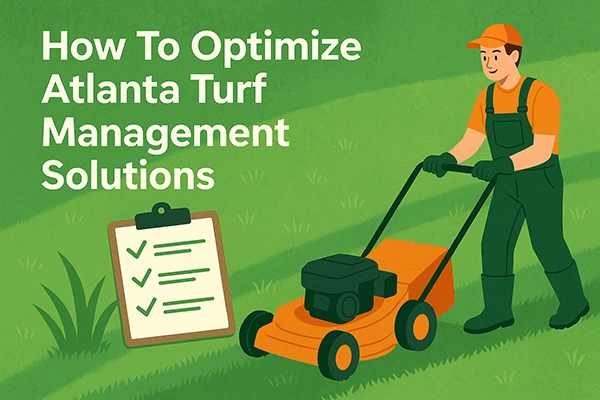
Have you ever stood back and wondered why your lawn never seems as lush, even green, as you find in the parks or affluent subdivisions?
You water, you mow regularly, and still, somehow it just doesn’t seem right.
Turf care in a city like Atlanta is complicated—unpredictable weather, heavy clay soils, and hot summer sun all impact your lawn’s appearance and health.
The bright spot? You are not alone, and there are proven methods to keep your turf healthy year-round.
Whether you have patchy, thinning areas, persistent weeds, or lackluster color, understanding how to tailor your strategy to Atlanta’s unique climate can revolutionize your lawn.
Here is a comprehensive breakdown of the optimal methods for elevating your lawn care to the next level.
From the ground to the seasons, every step is designed to provide you with the maximum payoff.
Read on to find out how to turn your lawn into a lush, green oasis.
1. Understanding Local Conditions Before Applying Turf Solutions

Atlanta’s climate presents a mix of challenges for lawn care enthusiasts. It has hot, wet summers and mild but fickle winters. This variation stresses the turfgrass, particularly on clay soils that are compacted and have poor drainage.
Without a targeted application, you can have a less-than-performing lawn even with maintenance.
To make the most of your lawn, it’s essential to coordinate with local environmental conditions. That means choosing grass species best suited for the region, adjusting mowing heights by season, and timing irrigation schedules in relation to rainfall.
This is where Atlanta turf management solutions enter the picture. These are developed according to the city’s unique soil composition, climate fluctuations, and native insects.
By paying attention to and following the same methods, you increase your lawn’s natural resistance and improve overall performance year-round.
2. Improve Soil Health with Regular Testing and Aeration
Your grass is only as good as the ground it’s rooted in. Perhaps the worst thing homeowners do is take their soil for granted and never have it tested.
A simple soil test will reveal pH issues, nutrient deficiencies, or compaction—both of which can hinder grass growth. Those can then be fixed with the correct amendments.
Aeration is another important method for enhancing soil structure. By pulling out small plug samples of soil, aeration facilitates the movement of oxygen, enhances water penetration, and breaks up compaction.
For Atlanta’s heavy clay soils, it is particularly helpful in promoting deeper root growth and reducing runoff from heavy storms.
A follow-up application of compost or organic-based fertilizers after aeration provides the maximum return by offering direct nutrition to the root zone.
Over time, these processes promote microbial activity and create a healthy environment beneath your turf, resulting in year-round, consistent color and appearance.
3. Use Strategic Fertilization Schedules Based on Season
Fertilization is not one-size-fits-all. For Atlanta, the nutritional requirements of your lawn vary throughout spring to fall, so it’s imperative to adhere to a seasonal calendar. Using the wrong type of fertilizer—or applying it at the wrong time—can result in overgrowth, illness, or nutrient burn.
In early spring, a balanced fertilizer should be applied to stimulate growth. When warmer weather arrives, switch to a formula with nitrogen to promote thick, green blades.
Later in summer, however, it’s time to lower the nitrogen level and begin promoting root growth. Fall fertilization makes your lawn strong for winter by establishing a sound foundation.
Timing and accuracy are everything. Therefore, use slow-release fertilizers that prevent sudden growth surges, and irrigate later to allow for maximum absorption.
Redefining your fertilizing schedule to match the climate of Atlanta ensures steady growth and prevents issues such as yellowing, patchiness, or weed domination.
4. Tackle Weeds and Pests Proactively, Not Reactively
Weeds and pests don’t wait for an invitation—they invade when your lawn is at its weakest. In Atlanta, typical offenders such as crabgrass, clover, and chinch bugs can quickly take over if left unattended. The trick is to be proactive, not reactive.
Start with pre-emergent herbicides in early spring to prevent annual weeds from germinating. As the season progresses, treat problem spots with selective herbicides to avoid damage to good grass.
For insects, maintenance surveillance is key. Inspect for discoloration, thinning, or abnormal patterns in your grass—these may indicate insect activity below.
Integrated pest management combines cultural controls (such as mowing and watering) with organic or synthetic pesticides to maintain pest issues in a state of control.
By staying ahead of infestations, you maintain turf density, reduce damage, and reduce the need for forceful chemical treatment in the future.
5. Embrace Smart Irrigation and Water Conservation
Watering your lawn is about more than just frequency—it’s about efficiency. Overwatering can cause fungal diseases, while underwatering stresses the turf, especially during Atlanta’s dry summer spells. Finding the right balance is key to maintaining optimal turf health.
Smart irrigation systems take the guesswork out of watering. These tools adjust schedules based on local weather conditions, soil moisture levels, and plant needs.
If a system isn’t in your budget, you can still follow best practices: water early in the morning to reduce evaporation and aim for deep, infrequent soakings rather than daily light watering.
Mulching your lawn clippings helps retain moisture, while aeration improves water penetration. These simple adjustments reduce runoff, lower your water bill, and support long-term turf vitality. By conserving water and applying it strategically, you enhance your lawn’s ability to withstand drought, disease, and heat stress naturally.
Conclusion
You now have the tools to transform your lawn into the envy of the neighborhood.
By aligning with Atlanta’s unique climate and soil conditions, your turf can thrive year-round.
Don’t settle for patchy grass—apply these strategies consistently and watch your lawn come alive with vibrant, lush green health.
It’s time to take control of your turf today!

